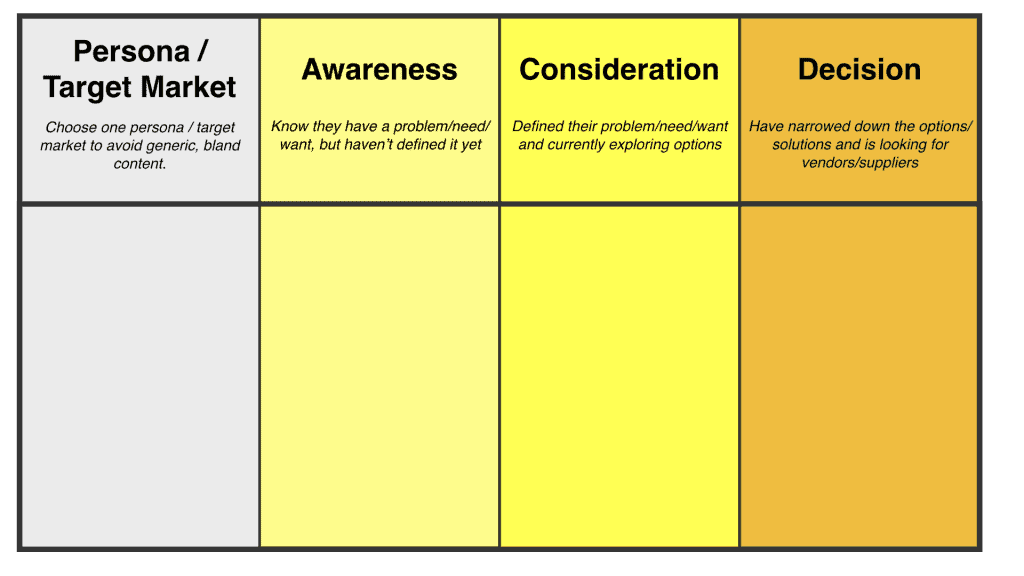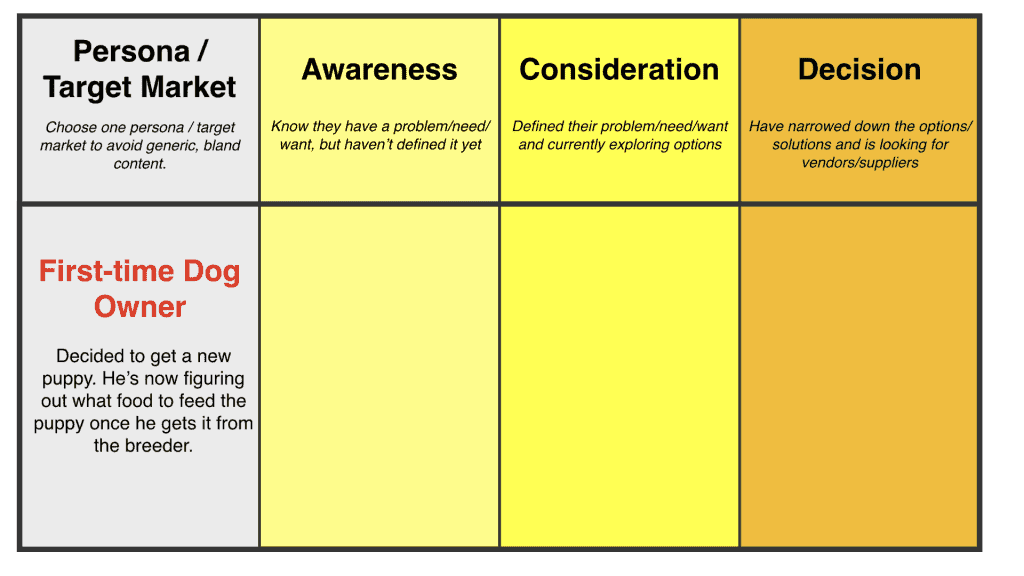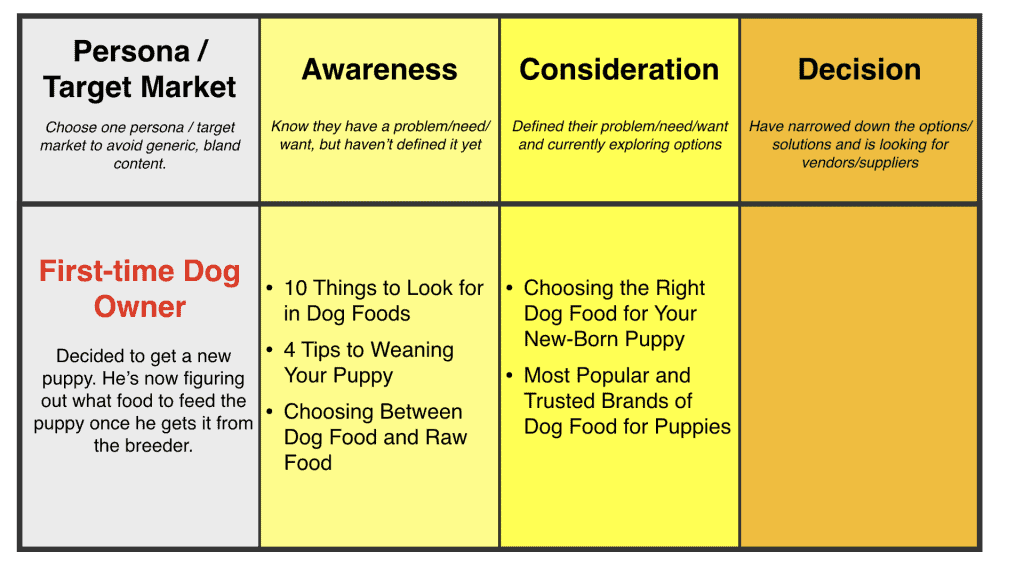Content mapping is a digital marketing tactic that allows you to build an effective content marketing strategy. It’s where you align content with your target market and display it visually.
It’s simple and easy to do.
I broke it down in 5 easy steps below.
Content Mapping in 5 Easy Steps
Step 1: Create a Table
All you need to do is create a table of your own like the one below.
No need for fancy software.
When I do this process, I usually just draw on my notebook.
You can plot it out like the example I used above — where the buyer’s journey is on the y-axis.
Or you can do it where the buyer’s journey is on the x-axis. It really depends on your preferences.
Step 2: Identify Your Target Market
This step can be as simple or as complicated as you like.
In most cases, you’ll hear marketers use the word personas. But that is an entirely long topic by itself, so I’ll keep it simple and use “target market” here.
Since we’re an e-commerce pet store, I’ll choose first-time dog parents as my target market. Obviously, there are a lot of different groups you can sell to if you’re a pet store like a full-pledged dog owner, or it can be a veterinarian or a first-time cat owner. The list goes on.
But the point of having personas or a clear target market is so you avoid generic content.
Generic messages are ineffective.
They don’t resonate with anyone. While the intent is pure — you want to target a lot of people — it actually hurts your brand because it is unappealing.
Untargeted content is the work of lazy marketers.
Lazy is not effective.
You don’t want to be that lazy marketer.
Step 3: Identify ONE Problem or Opportunity Your Target Market Needs Help With
The next step is to identify ONE thing that you want to solve. Naturally, this has to be something that is related to what you do.
Continuing our example, let’s use the problem of choosing the right dog food.
Again, there are dozens of options here even if you’re targeting the same persona. For example, for first-time dog parents, some topics you can write about are as follows:
- Potty-training your puppy
- Exercise for your puppy
- Training your puppy to learn basic commands.
You can tackle these topics later on.
But for now, just choose one so you don’t get overwhelmed.
Step 4: Brainstorm Content Ideas per Stage in the Buyer’s Journey
This is arguably the most complicated step in this process.
Now is the time to squeeze all the creative juices you have and plot out some content ideas for each stage in the buyer’s journey.
Let’s start with the awareness stage.
If you noticed, the topics listed in the example are stuff our target market will ask if they are starting their buyer’s journey — they know they need to feed their puppy, but don’t know what to look for or even use.
Stepping back a bit, the fundamental lesson in the buyer’s journey is not everyone who interacts with your brand is at the same stage. So, if you only talk about dog food, you could be alienating those who are used to feeding their dogs leftover human food, or those who want to try out the raw meat diet.
Of course, there are pros and cons with each of these methods. You can choose to ignore those groups as part of your content strategy. But you have to be prepared of the consequences of that decision — the biggest one being those who are searching for raw food won’t be interested in you. You’ll have zero chance of convincing them later on that dog food is better.
The next stage is the consideration stage. After learning about what goes into dog food and what puppies need, our target market has now decided that dry dog food is the best.
Now, they are left with dozens of choices of dog brands. For some brands, there are even special kinds of diets and formulations.
This will leave our first-time dog parent confused.
But they have you to guide them through this stage as well. You create content that educates them on the popular and trusted brands.
You even included what criteria they need to know before choosing the right dog food for them.
They are now in the decision stage. This is the time where you can use content to convince them that your products are the best out there.
They have narrowed down their choices to a handful. It’s now time for them to actually look at specific product reviews and what other pet parents are saying about them.
If you look at the content examples, they are product-focused. It shows a head-to-head comparison with your competitor (or in this case, a product you probably are not carrying).
Stepping Back A Bit
If you noticed, it’s only at the consideration and decision stage that you talk about specific product/service details.
And if you look at it closely, in the consideration stage, you’re only talking about your product/service category in general. Or you’re comparing it to the other alternatives and substitutes.
It’s really only in the decision stage where you get to talk about yourself or your product/service offering.
You can use the 5 stages of awareness framework to learn more about this.
Contrast this to a lot of content that you see out there. Almost all of them follow a certain theme and it goes like this.
Here are our products/services. We’re awesome. Buy from us now. Here’s a discount. Still don’t want to buy? Here’s some free shipping!
This is the biggest mistake a lot of marketers make. They don’t consider the buyer’s journey. They only look at it from the perspective of the organization.
No one likes that — especially if that is the only content you have.
Your customers are not dumb. If the only content you produce is about you, they’ll soon realize that all you care about is their money.
A good rule of thumb is to keep your salesy content to 20%, while your helpful and educational content to 80%. Using the buyer’s journey, that would look like something like this:
- Awareness – 50%
- Consideration – 30%
- Decision – 20%
Step 5: Create the Content Starting from the Awareness Phase
Once you racked your brains in the previous step, now comes an easier but more time-consuming step — creating the actual content.
Why start with the awareness phase? Because if you’re like most organizations, you already have a lot of decision-type content. Also, when you create awareness-type content, you slowly become an authority in your industry. You’ll also reach a wider audience.
Think of creating content at the awareness stage as small deposits to a bank. The more you do it — in terms of frequency and amount — the higher the payoff later on.
When we ask for our customers’ money, we withdraw from this “bank.” As with any bank, you can’t withdraw more than what you deposited.
So, what are you going to do next
You just learned how to map your content to your target market and buyer’s journey. Now, you can start creating content that your target market will actually want to read and find helpful.
Have any questions? Don’t know how to get started? Let me know in the comments below!





